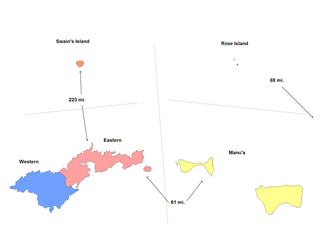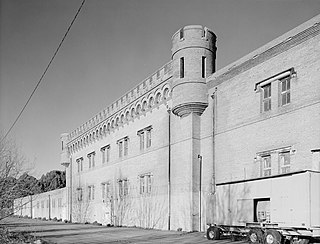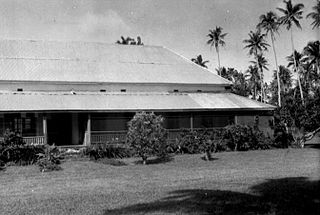
Pago Pago is the territorial capital of American Samoa. It is in Maoputasi County on the main island of American Samoa, Tutuila. It is home to one of the deepest natural deepwater harbors in the South Pacific Ocean, sheltered from wind and rough seas, and strategically located. The harbor is also one of the best protected in the South Pacific, which gives American Samoa a natural advantage with respect to landing fish for processing. Tourism, entertainment, food, and tuna canning are its main industries. Pago Pago was the world's fourth largest tuna processor as of 1993. It was home to two of the largest tuna companies in the world: Chicken of the Sea and StarKist, which exported an estimated $445 million in canned tuna to the U.S. mainland. It is the number one port in the U.S. in terms of value of fish landed - about $200,000,000 annually.

Canadian Forces Base Esquimalt is Canada's Pacific Coast naval base and home port to Maritime Forces Pacific and Joint Task Force Pacific Headquarters. As of 2018, 4,411 military personnel and 2,762 civilians work at CFB Esquimalt.

This is a list of the buildings, sites, districts, and objects listed on the National Register of Historic Places in American Samoa. There are currently 31 listed sites spread across the three districts of American Samoa. There are no sites listed on the unorganized atoll of Swains Island.

Fagatogo is the Downtown area of Pago Pago, the territorial capital of American Samoa. It is the government, commercial, financial, and shipping center of Tutuila Island. It is also the administrative capital of American Samoa. Fagatogo is the location of the American Samoa Fono (legislature), and is listed in the Constitution of American Samoa as the territory's official seat of government. Its population is 1,737.

Utulei is a village in Maoputasi County in the Eastern District of Tutuila, the main island of American Samoa. Utulei is traditionally a section of Fagatogo village, the legislative capital of American Samoa, and is located on the southwest part of Pago Pago Harbor. The A. P. Lutali Executive Office Building is located here, just next to Feleti Barstow Library and paved roads that wind up to the former cablecar terminal on Solo Hill. The Governor's Mansion sits on Mauga o Alii, overlooking the entrance to Goat's Island as well as the Lt. Governor's residence directly below it. The Lee Auditorium, built in 1962, is also located in Utulei. American Samoa's television studios, known as the Michael J. Kirwan Educational Television Center, and the Rainmaker Hotel, are also found in Utulei. Utulei Terminal offers views of Rainmaker Mountain.

Winehaven was a winery and town in Richmond, California, that held the title of "world's largest winery" for 12 years (1907–1919). It later became a fuel depot for the United States Navy.

The Sitka Naval Operating Base and U.S. Army Coastal Defenses are the surviving elements of the World War II-era defenses and defense establishments in and around Sitka, Alaska. These facilities, in particular the airfields and naval bases, played a key role in the defense of Alaska, and in military operations against Japanese forces which occupied Attu and Kiska, two remote islands in the Aleutian chain. The Sitka facilities were designated a National Historic Landmark in 1986.

Hangar One is one of the world's largest freestanding structures, covering 8 acres (3.2 ha) at the Moffett Field airship hangars site at Moffett Field, California, in Santa Clara County of the southern San Francisco Bay Area, California.

The Army and Navy YMCA is a historic YMCA building at 50 Washington Square in Newport, Rhode Island. It is a five-story concrete, masonry, and brick building, designed by Louis E. Jallade and built in 1911 by the Norcross Brothers. It occupies a small, irregularly-shaped city block at the upper end of Washington Square, Newport's historic civic center. The building was constructed in a Beaux Arts style, with limestone finish predominating on the main facades, with some terra cotta paneling. Mrs. Thomas Emery, a philanthropist from Cincinnati, Ohio, funded its construction to provide services for Navy members when Newport was a major center of the United States Navy. YMCA closed after the Navy significantly reduced its presence in Newport in 1973. The building now serves as low income housing.

United States Naval Station Tutuila was a naval station in Pago Pago Harbor on the island of Tutuila, part of American Samoa, built in 1899 and in operation until 1951. During the United States Navy rule of American Samoa, from 1900 to 1951, it was customary for the commandant of the station to also serve as Military Governor of the territory. Benjamin Franklin Tilley was the first commandant and the first officer responsible for the naval station's construction.

Naval Hospital Boston Historic District is a historic district at the south end of Broadway in Chelsea, Massachusetts. The district encompasses the area around the former Chelsea Naval Hospital. It consists of five buildings, historically the original 1836 Naval hospital, the 1857 Marine hospital, the Commanding Officer's quarters, and two ordnance buildings.

Government House, also known as Building No.1, Naval Station, Tutuila or Government House, U.S. Naval Station Tutuila, is a historic government building on the grounds of the former United States Naval Station Tutuila in Pago Pago, American Samoa. Built in 1903, it has served as a center of government on the island for much of the time since then. Government House was listed on the United States National Register of Historic Places in 1972, and was declared a National Historic Landmark in 1990.

The Blunts Point Battery, also known as Blunts Point Naval Gun or Matautu Ridge Gun Site, is a gun battery on Matautu Ridge near Pago Pago, American Samoa. It was part of the fortification of the Samoan Islands which took place after the attack on Pearl Harbor, and is a rare example of a World War II Pacific coastal gun which remains in relatively pristine condition. It was declared a National Historic Landmark in 1987.

Afao is a village in southwest Tutuila Island, American Samoa. It is located on the island's short southwestern coast, between 'Amanave and Leone, to the southwest of Pago Pago. It includes the settlement of Atauloma. Afao is home to two places listed on the U.S. National Register of Historic Places: Afao Beach Site and Atauloma Girls School.

The Michael J. Kirwan Educational Television Center, also known as KVZK-TV or KVZK Building, is a historic and current television center in Utulei, American Samoa. It is named for U.S. congressman Michael J. Kirwan, from Ohio, who took an interest in the development of American Samoa, and was instrumental in securing funding for a wide variety of improvements in the territory's infrastructure. It is a utilitarian concrete structure, roughly cruciform in shape, with a corrugated metal gable roof, located behind the Department of Education building on Route 1 in Utulei. It was built in 1964 as part of an innovative initiative to reform American Samoa's then-primitive educational facilities by broadcasting lessons from a central facility to the territory's remote schools. This initiative resulted in the widespread electrification of the territory's islands, and the construction of roads and new schools, and was widely regarded as a model for improving education in underdeveloped parts of the world. By the 1970s use of the broadcast facilities for education declined.

The Courthouse of American Samoa, formerly Administration Building, Navy No. 21, is a historic building near Pago Pago Harbor in Fagatogo, American Samoa. It is a two-story wood frame building mounted on concrete piers, with a two-story veranda on three sides. A concrete vault is located at the back of the building. The court house was reported by the local commander to have been completed about 1904. It housed the offices and other facilities from which the United States Navy administered the island from its construction until 1952, and was where advisory councils of the island's indigenous leaders were held. The building is one of the oldest standing in American Samoa, having survived typhoons and other perils.

The Fagalele Boys School, in Leone, American Samoa, is a historic building that was listed on the U.S. National Register of Historic Places in 1972. It is a church school built by the London Missionary Society, perhaps as early as 1850-1856, but before 1900. It was the first secondary school in what is now American Samoa, and it perhaps is the oldest surviving building on Tutuila Island.

The Rose Island Concrete Monument is a historic commemorative marker on Rose Island, part of Rose Atoll, a remote island located in the far eastern reaches of the territorial waters of American Samoa. The marker is a concrete structure in the shape of a truncated pyramid with a rectangular cross-section. It is 1.53 metres (5.0 ft) wide, 1.59 metres (5.2 ft) high, and 0.74 metres (2.4 ft) deep. On the west side of the marker is raised lettering stating "ROSE ISLAND / AMERICAN SAMOA / TRESPASSING PROHIBITED / WARREN J. TERHUNE / JAN 10 1920 GOVERNOR". A brass plaque on the opposite side of the monument conveys a similar message. The monument was placed in 1920 by the order of Naval Governor Warren J. Terhune during a tour he made of all of the islands of the territory of American Samoa, and serves as a continuing reminder of the American claim to the atoll.

The Breakers Point Naval Guns are a historic World War II-era defensive fortification on the island of Tutuila in American Samoa. It consists of two six-inch Mark 8 Model 2 naval guns, mounted on circular concrete platforms about 200 feet above sea level at the end of Papatele Ridge, which flanks the east side of Pago Pago Harbor. The guns, manufactured in 1907, were emplaced in 1941 amid fears of a Japanese invasion of the island, and were left in situ after invasion fears subsided. They were brought to the site by an innovative railway system that used locally crafted rails fashioned out of ifil wood when steel rails were not available. The guns are located on private family-owned land, but may be hiked to with permission.

The Jean P. Haydon Museum is a museum in Pago Pago dedicated to the culture and history of the United States territory of American Samoa. It contains a collection of canoes, coconut-shell combs, pigs’ tusk armlets and native pharmacopoeia. It also houses exhibits on natural history, tapa making, traditional tattooing, as well as a collection of war clubs, kava bowls, and historic photographs. Constructed in 1913 as U.S. Naval Station Tutuila Commissary, the building was home to Tutuila Island's Post Office from 1950–1971. The museum has displays of various aspects of the Samoan Islands’ culture and history. It is the official repository for collections of artifacts for American Samoa. Funded by the American Samoa Council on Arts, Culture and the Humanities, it is the venue used for numerous of the cultural resource activities in American Samoa.
















